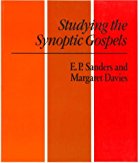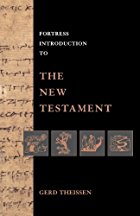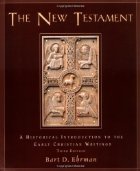Part 1: A Sea Change
Published in 1989 by SCM Press, Studying the Synoptic Gospels remains one of the best resources for learning about the first three books of the New Testament. Not a week goes by that I don’t take it off the shelf and refer to it. Sanders and Davies cover most of the important subjects related to synoptic studies, and they do it in an engaging and evenhanded manner. Each subject receives appropriate coverage, with suggested “further readings” that can take you even deeper.

Studying the Synoptic Gospels treats the question of genre quite seriously, devoting one chapter for each gospel. The chapter on Matthew for example, continues for 14 pages, touching on its various features — how it resembles different forms of known, contemporaneous literature, how it uses the traditional material, etc. In the end, the authors conclude:
The most satisfactory definition of the genre is ‘a theodicy about the creation and recreation (see palingenesia, ‘new world’, 19.28) which is centered in the life, death and resurrection of Jesus.’ (p. 264, italics original)
The authors contend that although in some ways Matthew’s gospel resembles a βίος (bios), it also has some striking differences, and in the end, it is a wholly inadequate description. Mark has even less in common with ancient literary biographies. They write:
The form of the Second Gospel is, however, even less like a Hellenistic biography than that of Matthew. It does not begin with birth stories, and, if 16.8 is the original ending, it is quite without parallel. (p. 267, bold original)
The authors grant that Luke has even more in common with Hellenistic biographies than the first two gospels.
It is fair to say that Luke-Acts could not have existed in its present form without knowledge of Graeco-Roman texts. . . . But, to return to the preface, the truth for which the work offers Theophilus assurance is not just the accurate reporting of past events, nor the discernment of patterns of history, nor the exact depiction of a holy community worthy of imitation or admiration, but the story of the creator God who repeatedly offers people salvation, through prophets, through Jesus and through his apostles, and whose sovereignty is about to be finally established by replacing the kingdom of Satan on earth with that of God. Historical motifs are swallowed up by eschatological, and history is understood from the perspective of creation and recreation. (p. 297, emphasis added)
Ultimately, the problem with identifying the genre of the synoptic gospels as Hellenistic biographies or Graeco-Roman histories is that these terms are insufficient to describe their form, genesis, and purpose.

Now compare Sanders’ and Davies’ careful, detailed, and sober conclusions to this quote from the Fortress Introduction to the New Testament by Gerd Theissen:
The gospel is a variant of the ancient ‘life’, which was widespread in the non-Jewish world: the gospel is an ancient bios (a better term to use than ‘biography’), though a bios of an unusual kind. (p. 16, Nook edition, 2004, bold and color emphasis added)
Theissen notes that writings centered on a single person were quite unknown in the Old Testament. How did a sect that started within Judaism come to employ a genre that was so unlike anything known in Jewish religious writings up to that point? He says:
The change to a Gentile audience encouraged a trend to develop the Jewish form of the prophetic book (as we have it in Q) into a Hellenistic bios. In the non-Jewish milieu there was nothing strange about concentrating a literary genre on a person. (p. 86, Nook edition)
In fact, Theissen contends that the gospels could only be written once the new sect had become predominantly gentile.
In the monotheistic milieu of Jewish Christianity it was impossible to write a bios of Jesus in which there was even the slightest indication that on the basis of his own words and works Jesus had claimed to be God or Son of God. That would have been blasphemy. (p. 86, Nook edition)

From the same year (2004), Bart Ehrman’s introductory textbook, The New Testament: a Historical Introduction to the Early Christian Writings, came to the same conclusion:
Many recent scholars have come to recognize that the New Testament Gospels are a kind of ancient biography. (p. 64, bold and color emphasis added)
Consensus in biblical scholarship tends to move slowly. It takes time for new perspectives to become known, with successive scholars fleshing out new theories. We expect to see lots of give and take, reappraisals, retrenchment, and so on. However, in the case of gospel genre, something earthshaking must have happened between 1989 and 2004 that caused a fundamental change in the consensus.
Not only did the consensus change, but a new, ready-made narrative to explain (and denigrate) the old consensus became “common knowledge.” Ehrman explains:
Until recently, modern scholars generally agreed that the New Testament Gospels were unlike anything else in all of literature, that they were an entirely new genre invented by the Christians, and represented by only four surviving works. The Gospels were obviously about the man Jesus and thus were somewhat like biographies, but compared to modern biographies, they appeared altogether anomalous. (p. 62, bold emphasis added)
Theissen and Ehrman are in fact describing a widely held consensus in scholarship today. What was it that so abruptly and decisively changed the minds of a majority of NT scholars? Largely, we have to credit Richard Burridge’s book, What Are the Gospels?: A Comparison with Graeco-Roman Biography (first published in 1992, updated in 2004). Vridar readers will no doubt recall Neil’s review, “Are the Gospels Really Biographies? Outlining and Questioning Burridge.”
Though other similar works preceded it (especially Charles Talbert’s What Is a Gospel?), Burridge’s book and its subsequent reception by scholars led to a sea change in they way people think about the gospels. Burridge himself seems to have greeted the reception and tidal change with a mixture of surprise and delight. Chapter 11, “Reactions and Developments” charts the history of the genre debate after the book’s first publication in 1992, and notes that at least two of NT superstar scholars have treated the Burridge thesis favorably, warmly embracing its conclusions. James D. G. Dunn, for example, “uses my work to argue for the biographical genre of the gospels as a basis for his latest reconstruction of Jesus.” (Burridge, p. 287)
Coming up next
In this series, we’ll take a look at the history of gospel genre studies in the 20th and 21st centuries. We’ll start with the work of the form critics, especially Karl Ludwig Schmidt, whose work today is largely ignored, widely misunderstood, and mostly still untranslated from the original German. We’ll see how the English-speaking scholarly world continues to misunderstand the pioneers of Formgeschichte (Bultmann, Dibelius, and Schmidt) and discover how a naive misapprehension of their work has contributed to the new consensus.
After that, we’ll take a look at the work of Burridge and others who have shaped the new consensus, and we’ll examine the psychological receptiveness of the scholarly community who almost seemed to be waiting for someone to tell them, “It’s OK to believe that the gospels are biographies.” Why were they so receptive to the message? And how does the belief that the gospels are ancient biographies affect the quest for the historical Jesus?
Next Post — The Genre of the Gospels: How the Consensus Changed (Part 2)
If you enjoyed this post, please consider donating to Vridar. Thanks!

“Until recently, modern scholars generally agreed that the New Testament Gospels were unlike anything else in all of literature.”
Only if by “modern scholars” Ehrman means “credulous Bible students eagerly seeking rationales for apologetics.”
The Gospels are not unique. The Life of Pythagoras, Philo’s Life of Moses, the Life of Apollonius of Tyana are some of the better-known examples of the collision between sacred myth and historicizing legendary or semi-legendary figures.
What was unique was specifically combining Josephus with Homer and sacred myth, and then declaring that no more in that style could be written after a short period of time. An unusual set of circumstances occurred to make them appear more singular than they otherwise would have appeared.
I’ve already demonstrated that “Mark” parallels better with Oedipus than The Life of Julius Caesar using Burridge’s criteria:
http://www.amazon.com/What-Are-Gospels-Comparison-Graeco-Roman/product-reviews/0802809715/ref=cm_cr_pr_hist_1?ie=UTF8&filterBy=addOneStar&showViewpoints=0
Using proper criteria it parallels much better. The question that should be asked here is not what are the genre of the Gospels, it is how has the genre CHANGED. “Mark” parallels best with Greek Tragedy. “Matthew” moves towards Bios. “Luke” moves farther towards it. “John” moves beyond Bios to witness statement.
The key to all of this is the author’s attitude towards historical witness:
“Mark” = Discredit historical witness
“Matthew” = Convert “Mark’s” characters to witnesses
“Luke” = Convert “Mark” to witness
“John” = Exorcise “Mark’s” base of discrediting historical witness
All talk of Gospel genres is secondary to this.
Joseph
Nice, Joe. But even with other emphases, John didn’t actually condradict Mark. To me, it was as if John was actually written by John with a firsthand view of Jesus and a huge ego about it. But I’m not a scholar who has read enough of the works done on this topic either. I just use my own observations up to this point and am now slowly adding what I can as Vridar keeps informing me of more.
There’s a huge gulf of writing style between the John who wrote the apocalypse and John who wrote the gospel. The gospel is way too sophisticated and had way too good a grasp on the Greek language to have been written by a native Aramaic speaker. Contrast that with the poor Greek in the apocalypse; that one has a higher probability of being written by someone whose grasp of Greek wasn’t all that stellar.
It’s like comparing Shakespeare with YouTube comments. You wouldn’t think they could be written by the same person.
Thanks J. Quinton! But since later rendentions of those are all that exist–second century at the very earliest–couldn’t some of that language transition that was done by others later have been what gave one more sophistication over another since perfect translation might not have been the primary goal (not to mention the skills of the translator), as we know pretty well now how that not maintaining perfect accuracy seems to have fairly often happened as this movement moved from the first century into the second? Therefore John could have written both the Gospel of John as well as Revelation, perhaps. But we don’t have those originals to see for sure… is at least how I’m seeing that at this particular time.
There are several reasons scholars generally consider Revelation to be authored by someone quite unlike the author of the Gospel of John. Rather than list the details here I’ll do a post.